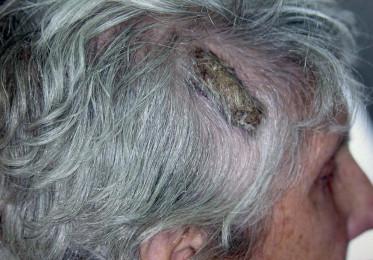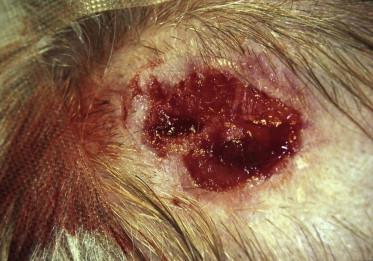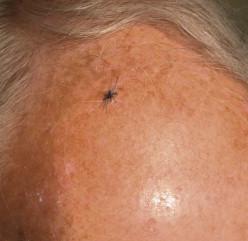Physical Address
304 North Cardinal St.
Dorchester Center, MA 02124
The skin biopsy is essential to dermatologic surgery both in diagnosis and planning therapy.
Several biopsy techniques are available, including shave, saucerization, curettage, scissors “snip,” punch, and scalpel excision, or incisional biopsy.
Complications are infrequent but can be minimized by careful preoperative evaluation for risk factors and by meticulous technique.
The biopsy site should be selected carefully taking into account factors likely to give the optimal information, the aesthetic consequences and the planned therapy.
The choice of technique depends on the type of lesion (e.g., benign vs malignant), size, site, and the purpose of the biopsy. The intention may be to remove an entire lesion or to incise a small part of the pathologic process.
Clinicopathologic correlation is key to making the final diagnosis.
Skin biopsy is a technique by which a sample of skin is removed for the purpose of further examination in the laboratory – normally using a microscope. It is an essential part of the dermatologist's diagnostic repertoire. The term excisional biopsy is usually reserved for the process of removing, in its entirety, a solitary skin lesion. Incisional biopsy refers to the removal of part of a lesion or dermatological condition. Terms such as punch, shave, and curette biopsy define more accurately the method used.
The clinician and pathologist both contribute to patient care by reaching a diagnosis which leads to therapeutic interventions. The pathologist can only offer a meaningful differential diagnosis if he has been given adequate information and an optimal skin biopsy. The timing of the biopsy, its size and depth, the site of origin and the fixation technique are all important factors which assist the pathologist in forming an opinion. Even so, it may not be possible to make an unequivocal diagnosis but from the clinician's point of view, it may be sufficient, for example, to exclude malignancy or in the case of alopecia to state whether it is scarring.
Biopsies may be used to monitor the progress of a disease through its natural history or in its response to therapy ( Box 11.1 ). This is particularly relevant in research projects when the success of a new treatment can be evaluated both clinically and microscopically. A further use is to take multiple punch biopsies around a poorly-defined tumor to aid with assessment of its margins.
Achieve precise diagnosis
Exclude specific diagnoses
Provide histologic support for a clinical diagnosis
Determine extent of a tumor (“scouting” biopsies)
Monitor evolution of disease
Monitor response to treatment
As a treatment to excise a tumor
Debulking staged procedure, e.g., serial excision of lentigo maligna
Remove disfiguring tissue as a cosmetic procedure
Aid healing, e.g., punch excisions to fenestrate ear cartilage in second intention healing
Diagnose non-cutaneous disease, e.g., genetic or connective tissue disease, systemic amyloidosis, peripheral neuropathy
Well-developed lesions may give the best pathologic information with the center showing the most established features, but blisters and annular lesions often show most change at the active edge.
Certain sites are likely to heal quickly and leave reasonable scars, whereas other sites are prone to delayed healing, infection, and unacceptable scars. In addition, pathologic changes due to gravitational effects, for example the lower legs, may cloud the histologic picture. Biopsies overlying bony prominences may show nonspecific lymphocytic infiltrates and epidermal hyperplasia. It may not be possible to avoid a poor healing area; but if there is a choice, the physician will try to avoid taking skin from below the knee and generally the upper body is better than the lower body. Some general principles that affect the cosmetic result are that:
Infection is more common below the knee
Scars on the back often stretch
The ventral forearm often has a poor result
The dorsum of the hand heals well
The central face should be avoided if possible.
Dermatologists are ideally placed to take skin biopsies because they have the training to make decisions about the appropriate type of biopsy. There will be occasions when, viewed retrospectively, the ideal biopsy was not taken, e.g. a shave biopsy of a suspected seborrheic keratosis, which is subsequently reported as a thick melanoma. But dermatologists' understanding of the biology of skin disease enables them to make the right decision most of the time.
Some important general principles follow:
As an eruption evolves, lesions may show more diagnostic features but older resolving lesions may lose the characteristic changes.
It is best to avoid excoriated or secondarily infected lesions.
Pathologists prefer material from the centre of a plaque but the edge of expanding annular lesions such as granuloma anulare.
Incorporating some normal skin in a diagnostic biopsy helps the pathologist to compare normal with abnormal, e.g. in hyper or hypo-pigmentation.
Orientation of the biopsy can help the pathologist, in processing, to achieve a representative sample, e.g., placing a suture or a nick at one pole of a circular specimen.
Distinguish between keratin and crust. Crust should be removed gently by irrigation prior to biopsy ( Figs 11.1 , 11.2 ).


Shave excision or curettage is often appropriate for epidermal lesions. However, sometimes a deeper biopsy will give further information, such as the thickness of a basal cell carcinoma.
Biopsies of dermal lesions need deeper tissue, so the best techniques are incisional, elliptical excisional or punch biopsy.
Pathology in the subcutaneous tissue can only be assessed if biopsies to the deep fat are taken. Although punch biopsy may be adequate, it is generally better to take a wide elliptical piece of tissue. In some cases of panniculitis, this may need to be over 2 cm deep.
The edge of an ulcerated lesion may show pseudoepitheliomatous changes. It is best to include some normal skin and to avoid small specimens.
In some disorders, e.g. dermatitis herpetiformis, only very recent lesions are helpful and even then the histological changes may be nonspecific. Further laboratory tests, e.g., specific serological markers for gluten-sensitive disease may help to clinch the diagnosis.
Serial sections are useful when the clinical diagnosis does not match the histopathology.
In areas with multiple actinic lesions, it is easy to “lose” the biopsy site a week later when the pathology is reported. This is awkward if further treatment is needed. Marking the biopsy site with a suture, even after a curette biopsy, helps to avoid this difficulty ( Fig. 11.3 ).

The interdependence of pathologists and clinicians is seen in many ways. The clinician must provide an appropriate biopsy, sent in the correct transport medium and with enough clinical detail written on the request form which will allow the pathologist to understand what is being asked of him. Larger biopsies are much easier to process. All biopsy specimens must be carefully labelled, including the names of the patient and physician and the date. The precise site of the biopsy should be stated and ideally a diagram provided. Previous biopsies or previous treatment to the affected area should be disclosed. A likely clinical diagnosis or a differential diagnosis should be given. The intent must be clear, i.e. excisional vs incisional. Specific questions may be asked to allow the pathologist to choose from a range of tinctorial stains, e.g.: “Are there increased numbers of mast cells?”; “Is there any excess mucin?”; “Any evidence of fungal elements?”; “Any foreign body material under polarized light?”. The pathologist may choose to read the supplied information before looking at the slides or prefer initially to study the slides “blind” so that they are not biased by the information. Urgent requests can be flagged up for rapid reporting. In emergencies or particularly challenging cases, it is worth discussing the case with the histopathologist and showing him the clinical photographs. Some conditions are notoriously difficult to confirm histologically, e.g., mycosis fungoides, morphea and porokeratosis. These entities may prove “invisible” and result in false-negative results, especially with limited clinical information. Multiple biopsies may be needed.
Care should be taken when handling the tissue to allow for the most accurate interpretation of changes. If three or four studies are to be performed on the tissue, it is often best to take more than one specimen, rather than divide one specimen into three small pieces, to avoid crush artifact.
Most diagnostic pathology is performed on paraffin-embedded material, and 10% neutral buffered formalin is the usual fixative. It is helpful to visit the pathology department and watch the technicians cutting and embedding tissues, maintaining the correct orientation until the wax begins to set. It becomes clear why tiny punch biopsies may often result in a report which comments on poor orientation and subsequent cross-sectioning.
Whereas immunoperoxidase methods may be applied to sections from paraffin-embedded tissue, the immunofluorescent (IMF) technique usually uses tissues which have been snap frozen in liquid nitrogen, cut in a cryostat, and stained without fixation. Other transport mediums, for example normal saline or Michel's medium, can be used depending on local arrangements. It is usually a specific area, for example the basement membrane, that is being studied and only small biopsies are required. In the case of a blistering disorder, it is common to take an ellipse through a blister and to remove a 2–3 mm piece of the perilesional skin for IMF.
This is used for the diagnosis of cutaneous lymphoma when T-cell receptor gene rearrangement studies are performed. Formalin-fixed or snap-frozen skin is used.
Cytology is used widely in disciplines such as cervical diagnostics but is little used on primary skin lesions. Exfoliative cytology and fine-needle aspiration (FNA) offer advantages such as time- and cost-effectiveness. It is a conservative means of arriving at a pretreatment diagnosis of basal cell carcinoma (BCC). This could be beneficial where even a simple 2 mm punch biopsy may be considered inappropriate, such as in a cosmetically sensitive site in a young person or when non-surgical therapies are planned. Normally, a scalpel blade is used to scrape the surface of the lesion; the material is then scraped onto a slide which is fixed, stained, and immediately viewed under a microscope. Bakis and colleagues performed a meta-analysis to ascertain the diagnostic accuracy of exfoliative cytology for BCC. The methodological quality was, in general, poor but a pooled sample of 1261 BCCs showed the sensitivity to be high at 97%. Only 3% of BCCs included were misdiagnosed as non-BCC by cytology. The corresponding pooled specificity was 86%.
Exfoliative cytology is not recommended in the diagnosis of cutaneous squamous cell carcinoma or melanoma but FNA has an important role in biopsy of lymph nodes. Ultrasound-guided FNA is performed by radiologists who can sample pathologic nodes in axillary, inguinal, and cervical regions. However, if the enlarged lymph node is easily palpable, it can be sampled without ultrasound using an 18-gauge needle attached to a 2 mL syringe containing 1 mL of normal saline. Tiny core fragments obtained are expelled with the saline into a universal container that is then spun down by the cytologist before mounting and staining. This can give a quick result.
Cytodiagnosis is also used in the diagnosis of bullous disorders and vesicular viral eruptions.
Fresh unfixed tissue may be cultured for various organisms, including staphylococcus, mycobacterium, and fungi, or examined for protozoa or filarial worms. Such specimens tend to be placed in normal saline solution and transported to the laboratory immediately. A special sealed vial is required for anaerobic culture. Prior discussion with a microbiologist is advisable so they know to expect the specimen.
Become a Clinical Tree membership for Full access and enjoy Unlimited articles
If you are a member. Log in here